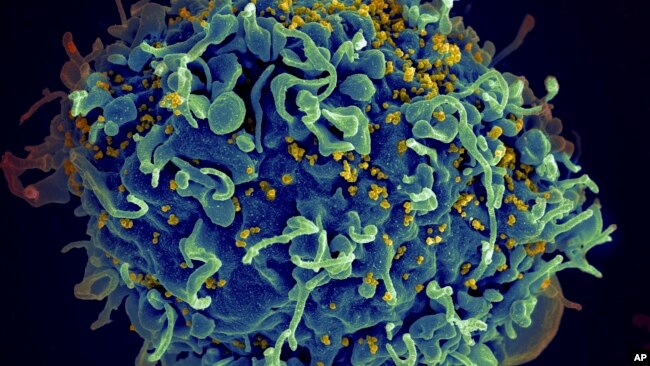「気候変動が最良のシナリオであっても、予防は不可能」との予測は絶望的です。なんとしても、世界各国で努力しなくてはなりません。例外はあり得ません。コロナがなければ・・・・まだ。
VOAで英語を学びましょう!!
研究結果: 気候変動が動物におけるウイルス拡散を促進する可能性(和訳)
Study: Climate Change Likely to Increase Virus Spread in Animals
May 06,2022
新しい研究によると、気候変動により、2070年までに数千種類の新しいウイルスが多くの種類の動物の間で蔓延すると予測されています。研究者によると、このような広がりは、動物からヒトに感染する新たな病気のリスクを高める可能性が高いと言います。
研究対象は、約3,000種類の哺乳類で、いくつか例を挙げるとネコ、コウモリ、クジラ、ヒトなどです。科学者たちは、世界が摂氏2度温暖化した場合、今後50年間にこれらの種がどのように移動し、ウイルスを共有するかを見るためのモデルを作成しました。最近の研究では、そのような温度上昇の可能性が示唆されています。
研究チームは、このモデルによって、哺乳類の間で種を越えたウイルスの拡散が4,000回以上起こると予測したと言います。
研究者によれば、すべてのウイルスが人間に感染したり、COVID-19のような広範なパンデミックに至るわけではないと言います。しかし、この研究は、種を越えたウイルスの数が多ければ多いほど、ヒトに広がるリスクが高くなることを示唆しています。
この研究結果は、最近出版されたNatureに掲載されました。
この研究は、動物からヒトへ病気を移す原因となりうる世界的な2つの大きな危機、すなわち気候変動と感染症の蔓延を指摘しています。
これまでの研究では、森林伐採、種の消滅、野生生物の取引などが、どのように動物からヒトへの病気の伝播につながるかを調べてきました。しかし、気候変動がこの種の病気の蔓延にどのような影響を及ぼすかについては、あまり研究されてこなかった、と研究者たちは述べています。
「我々は、zoonosesズーノーシスの文脈では、気候についてあまり話をしません。」この研究の共同執筆者であるワシントンD.C.のジョージタウン大学生物学教授のコリン・カールソン氏は、述べています。「zoonoses(人獣共通感染症)とは、動物から人へ感染する病気を指す言葉です。「私たちの研究は、...私たちが直面している2つの最も差し迫った地球規模の危機を一緒にしています。」とカールソン氏は付け加えています。
気候変動と感染症に関する多くの専門家は、地球が温暖化することで新しいウイルスが作られるリスクが高まる可能性が高いという点で一致しています。
ダニエル・R・ブルックスは、ネブラスカ大学州立博物館の生物学者で、The Stockholm Paradigm: Climate Change and Emerging Diseaseの共著者です。同氏はAP通信に対し、最新の研究は、新たな病気の脅威が気候変動と関連づけられるという考えを支持していると述べています。
ブルックス氏は、気候変動によって新たな感染症が蔓延する可能性について、”今回の貢献度は極めて保守的な推定値である”と述べています。
アーロン・バーンスタインは医学博士で、ハーバード大学T.H.チャン公衆衛生大学院の気候・健康・地球環境センターの現所長です。この研究は、地球温暖化が新たな感染症の発生に及ぼす影響について、長い間疑われてきたことを裏付けるものだと彼は言います。
バーンスタイン氏は、この研究がそのようなケースが”すでに多くの人が住む場所の近くで、より頻繁に起こっている可能性がある”ことを示唆していると指摘しています。
研究の共同執筆者であるグレゴリー・アルベリー氏はジョージタウン大学の疾病専門家です。彼はAP通信に、気候変動による感染症はすでに発生している可能性が高いので、世界はそれについて学び、備えるためにもっと努力するべきだと語っています。
「気候変動のシナリオが最良のケースであっても、予防は不可能です。」とアルベリ氏は述べています。
Study: Climate Change Likely to Increase Virus Spread in Animals
A new study predicts that climate change will cause thousands of new viruses to spread among many kinds of animals by 2070. The researchers say such spread will likely increase the risk of new diseases that pass from animals to humans.
The research covered about 3,000 kinds of mammals, animals including cats, bats, whales, and humans, to name a few. The scientists created a model to see how these species might migrate and share viruses in the next 50 years if the world warms by 2 degrees Celsius. Recent research has suggested that such a temperature rise is possible.
The team said the model predicted that cross-species virus spread will happen more than 4,000 times among mammals.
The researchers said not all viruses will spread to humans or lead to widespread pandemics like COVID-19. However, the study suggests that the high number of cross-species viruses will increase the risk of spread to humans.
The findings recently appeared in the publication Nature.
The study points to two major worldwide crises that could cause diseases to be passed from animals to humans – climate change and infectious disease spread.
Past research has looked at how deforestation, the disappearance of species and the wildlife trade can lead to animal-human disease spread. But there has been less research on how climate change could influence this kind of disease spread, the researchers said.
“We don't talk about climate a lot in the context of zoonoses," said study co-writer Colin Carlson, a professor of biology at Georgetown University in Washington D.C. Zoonoses is a term for diseases that can spread from animals to people. “Our study ... brings together the two most pressing global crises we have," Carlson added.
Many experts on climate change and infectious disease agree that a warming planet will likely lead to increased risk that new viruses will be created.
Daniel R. Brooks is a biologist at the University of Nebraska State Museum and co-author of the book The Stockholm Paradigm: Climate Change and Emerging Disease. He told The Associated Press that the latest study supports the idea that new disease threats can be linked to climate change.
“This particular contribution is an extremely conservative estimate” for possible new infectious disease spread caused by climate change, Brooks said.
Aaron Bernstein is a medical doctor and current director of the Center for Climate, Health, and the Global Environment at Harvard University’s T.H. Chan School of Public Health. He said the study confirms long-held suspicions about the effects planet warming can have on the creation of new infectious diseases.
He noted that the study suggests such cases “may already be happening with greater frequency and in places near where many people live,” Bernstein said.
Study co-writer Gregory Albery is a disease expert at Georgetown University. He told the AP that because climate-driven infectious diseases are likely already being created, the world should be doing more to learn about and prepare for it.
“It's not preventable, even in the best case climate change scenarios,” Albery said.
Words in This Story
context – n. all the facts, opinions, situations, etc. relating to a particular thing or event
global – adj. worldwide
contribute – v. to give something in order to provide or achieve something together with other people
conservative – adj. a guess about a number that is likely lower than the true number or amount
frequency – n. the number of times something happens in a particular period
scenario – n. a description of what could possibly happen
